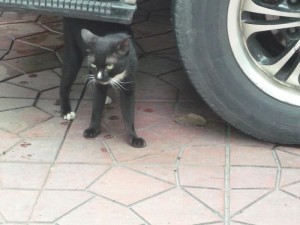
Here is another excerpt from my unpublished book for young people and general readers:
There are many stories of cats who have travelled incredible distances on foot, by car, train or plane. Many cats have demonstrated a remarkable “homing” instinct, which guides them back to their homes over many miles.
In England, a cat called Sooty made it home from 160km away. Another British cat, Pilsbury, walked the 12km trip to a former home at least 40 times – and each time was retrieved by its owners. The champion of them all, though, is an American tomcat called Ninja who moved with his owners from Washington State to Utah in 1996. He disappeared soon after they settled in their new home, but turned up at his old place – 1370 kilometres away – a year later.
Skittles, a scruffy orange cat, went missing after travelling with its owners to a trailer park in Wisconsin, 568km from its home in Kelly Lake, Minnesota. The cat disappeared and the owners went home without it. About six months later, Skittles returned to Kelly Lake with calloused paws and bones showing through its skin – indicating it had walked all or most of the way back.
Sometimes, though, cats don’t get home under their own steam. In 2001, an international rescue mission was mounted to save a New Zealand cat that had stowed away on a cargo ship bound for South Korea. The cat, a female named Colin, was adopted nine years previously by dock workers. Her safe return, accompanied by quarantine officials, was sponsored by a pet food company and the Korean airline. “She’s been a bit of a naughty girl but we’re all looking forward to seeing her again,” said John Hacon, a spokesman for the Westgate tanker company, on the eve of her return to Port Taranaki.
A Florida woman was reunited with her cat in 2004 – seven years after it went missing. The 10-year-old cat turned up 4500km away in San Francisco. Authorities said the feline, Cheyenne, didn’t walk all the way, though. She was either adopted by a Florida family who then travelled to California, or hitched a ride with a cross-country vehicle.
News that Cheyenne had been found and identified by her microchip reached owner Pamela Edwards on the same day she was forced to her other, 19-year-old cat put down. “It has just been an amazing experience,” Ms Edwards said. “It’s really like reuniting with a lost family member.”
In July, 2004, British officials were mystified when a cat found on the streets of the university town of Oxford was found to be carrying a microchip that was registered in the United States. RSPCA inspector Doug Davidson said there were three theories as to how the cat, nicknamed Jasper, got to be in the UK.
“The first is that he’s a strong swimmer,” he joked. “The second is that he belongs to Americans living in Oxford and the third would be that it was a British family in the USA who adopted him and then brought him back.”
Probably the most-travelled cat of all was called Hamlet, who escaped from his container in the hold of a Canadian jet. When he was found behind an aircraft panel seven weeks later, the plane had flown 600,000km.
Another cat, Ozzy, had a similar adventure. He completed 10 round trips from the Middle East to the UK over 10 days before he was found in the cargo hold of a British Airways jet.
Sources: Homing Instinct, PBS Nature television program, pbs.org; Current Science, March 5, 2002, Vl 87, Issue 16, page 13; Cat rescue mission reaches Korea, Whiskas press release on Scoop.co.nz, December 3, 2001; Microchip reunites cat with owner, BBC News (news.bbc.co.uk), August 30, 2004; US ‘ambassador’ cat baffles RSPCA, BBC News (news.bbc.co.uk), August 5, 2004; Julia Wilson, www.cat-world.com.au, 2002-2005; Stowaway cat clocks up 63,000 miles, BBC North Yorkshire (bbc.co.uk/northyorkshire), July 19, 2002
